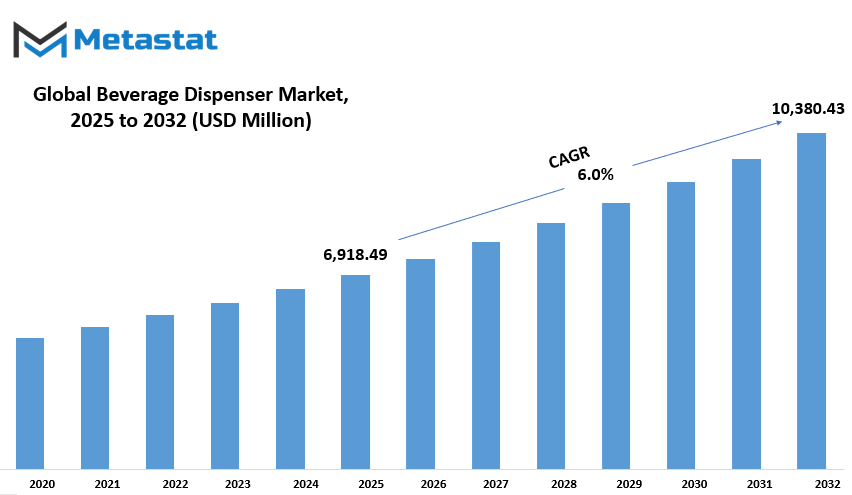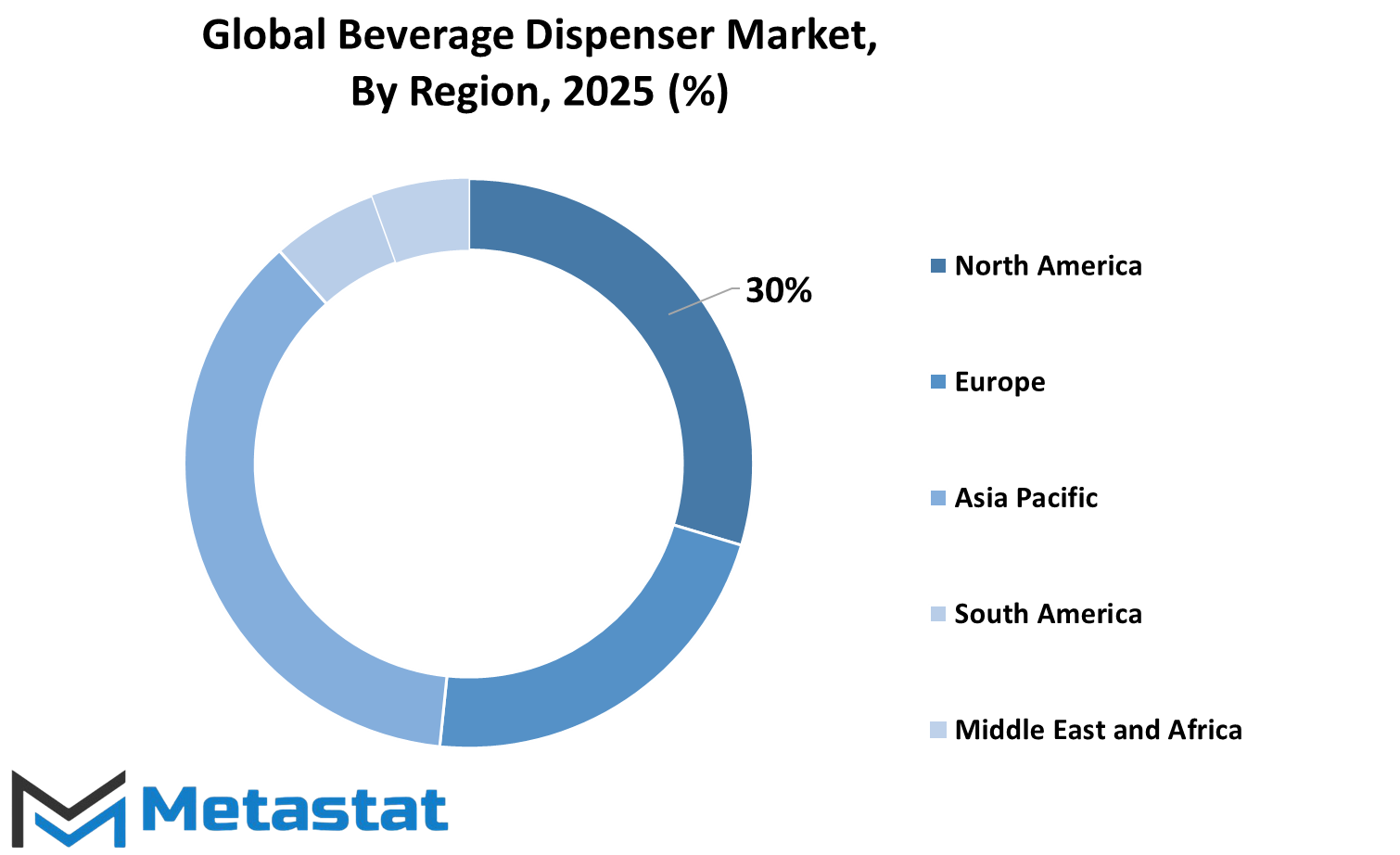MARKET OVERVIEW
The Global Beverage Dispenser market is an exciting segment in the commercial and consumer industries, which offers innovative solutions for serving beverages efficiently. Increasingly, attention has been drawn to this market, because of its enormous potential for revolutionizing the storage and delivery of beverages. Although it is more or less hospitality, food service, and retail sectors, it plays a very important role in the evolving residential consumers' needs. This essay delves deeper into the broader implications of the market, going beyond the traditional understanding of it. Less discussed about the Global Beverage Dispenser market is how it impacts product customization.
Manufacturers are innovating systems with flexible options regarding which beverages should be served and to what temperatures in volumes best serving individual requirements. These kinds of developments target maximizing consumer happiness as a tendency that has increased more personal preferences while drinking a beverage. That aspect is no longer exclusive to luxurious equipment and seems to percolate into more reasonable, including lower-cost alternatives that could ultimately achieve broader applications. The technological dimension of the market is another area that is ready for growth. Advances in sensor technology, IoT integration, and automation are changing the design and functionality of beverage dispensers.
These devices will increasingly feature smart features, allowing for remote monitoring and real-time adjustments to operations. As smart kitchens and automated commercial setups become more common, beverage dispensers will be at the forefront of streamlining beverage service operations and reducing waste. The next influence of Global Beverage Dispenser market is what it will imply for sustainability.
Companies are going green, therefore, seeking better materials that don't harm the environment, use less energy to operate, and reduce waste by using more recycle-friendly components and the design of such reusable parts in dispensers will most probably take after the reduction of plastic in the world while encouraging greener consumption. This transformation, driven by sustainability, will transcend manufacturing to touch marketing, distribution, and disposal practices. The market will also see considerable diversification in terms of beverage types. Dispensers will go way beyond the classic options that include soda, coffee, and juice, but will now be developed to include specialty drinks-those health-focused beverages and plant-based options. With diversification comes an array of unique and functional beverages.
As a result, there will be opportunities for brands to differentiate their products in the marketplace. Untapped regions with a rapidly expanding consumer base and developing infrastructure will be crucial market expansion venues. Here again, regional-specific solutions tailored to regional tastes and cultural practices will stimulate growth in these regions. This regional perspective highlights the need for adaptability in the market and to understand diverse audiences. Finally, the Global Beverage Dispenser market will contribute toward reimagining social spaces. Whether in an office, cafes, or in public venues, these dispensers will become centerpieces for crafting interactive environments whereby consumers engage beverages as part of a larger experience. In this regard, this evolving role suggests the market will influence how to consume beverages as a communal activity.
In conclusion, the Global Beverage Dispenser market is positioned to redefine beverage consumption through technological, environmental, and cultural advancements. Focusing on customization, sustainability, and innovation, this industry will pave a way to a future where beverage dispensers are no longer just useful tools but help enhance consumer experience worldwide.
Global Beverage Dispenser market is estimated to reach $10,380.43 Million by 2032; growing at a CAGR of 6.0% from 2025 to 2032.

GROWTH FACTORS
The global beverage dispenser market is experiencing significant growth, driven by several factors shaping its development and expansion. One of the key factors propelling this market is the increasing demand for convenient and hygienic beverage solutions. Consumers today prioritize ease of use and cleanliness when it comes to accessing beverages, particularly in public or commercial settings. Beverage dispensers are an efficient way of addressing these preferences, which offer fast service in sanitary conditions. This demand falls in line with the general need to make life easy in, for instance, busy environments as that are the offices, schools, and hospitals. Another significant factor triggering this demand is the expansion of quick-service restaurants and food chains across the world.
Because the growing businesses necessitate strong beverage dispensers capable of fulfilling fastpaced customers coming in a multicultural community, high-performance, robust, and safe beverage dispensers become their indispensable tools, allowing operations to become less cluttered as customer satisfaction improves through easier ordering services. These food establishments globally increase demands on beverage dispensers for areas within many other different countries around the world. However, there are some restrictions in the market which might act as a limitation for the growth of this market.
The high initial investment associated with sophisticated beverage dispensing systems is a major challenge. These machines generally require a huge amount of initial investment; hence, these machines become unaffordable for the smaller business or the business running within a lean budget. The continuous maintenance and frequent repairs in the commercial sectors act as a hurdle in front of cost-sensitive businesses. All of these may make a few potential buyers think twice, especially those in budget-constrained markets.
However, the beverage dispenser market is an exciting one for growth. A feature that stands out is how emerging smart and IoT-enabled dispensers can provide real-time monitoring, touchless operation, and customization. Such futuristic features will fulfill consumers' modern needs as well as business needs. Another potential area, therefore, for the expanding beverage industry would be emerging markets. Increasingly urbanized regions with growing disposable income create a burgeoning demand for innovation in beverage solution that can answer the needs and preferences of as wide a number of tastes and preferences as possible.
In summary, although the market is facing some challenges, the increasing demand for convenience, hygiene, and technological advancements ensures that the beverage dispenser market remains well-positioned for continued growth, both from established and emerging opportunities.
MARKET SEGMENTATION
By Type
Growing need of beverage dispensing solutions in industries drives the development of the market. The interest in beverages rises with its consumption in commercials and residential households. Restaurants, cafes, as well as businesses in offices prefer using beverage dispensers to promote satisfaction among customers and among their employees through hassle-free serving experiences. The focus on reducing manual effort, minimizing waste, and ensuring consistent quality in beverage service has significantly contributed to the expansion of this market. The market is further categorized by type, including hot beverage dispensers and cold beverage dispensers.
Hot beverage dispensers, valued at $2,972.88 million, cater to the growing need for coffee, tea, and other warm beverages in places like offices, hotels, and event venues. The hot beverage dispensers dispense hot drinks to guests efficiently and at the right temperature, making them a must-have for fast-paced environments. The cold drink dispenser is used in the dispensing of massive quantities of beverages, which include juice, carbonated water, and flavored water in restaurants, fast-food chains, and catering services. Advancement in technology is the key growth driver in the beverage dispenser market.
The modern dispensers are equipped with user-friendly interfaces, energy-efficient systems, and have features such as automated cleaning that make them attractive to businesses and to individuals. The increasing demand for sustainable solutions also has led to the development of eco-friendly beverage dispensers with less energy usage and reduced packaging waste. The consumer behavior of this market also is important. As people pay more attention to convenience and hygiene, touchless dispensers have become highly demanded. The pandemic has further expedited this trend, as companies look to put in place contactless solutions that ensure safety.
Overall, the global beverage dispenser market mirrors the increased demand for effective beverage solutions to cater to different consumers' needs. This market has a great chance of further expansion with continuous innovation and the trend of focusing on customer preferences. For both hot and cold drinks, dispensers have become one of the unavoidable aspects of modern living, simplifying service and experience for users in all corners of the world. The segmentation into hot and cold beverage dispensers highlights the market's ability to cater to a wide range of preferences, ensuring it remains a vital industry for years to come.
By Material
The global market of beverage dispenser segments its business division into various categories based on material. Materials of beverage dispenser such as plastic, stainless steel, and other comprise this kind of segmentation that tells the varied need of the customer along with businesses in all other parts of the world. For determining their long durability, aesthetic beauty, and their purpose of utilization in any area or house, it is more a material to decide which to opt for from any beverage dispenser.
Plastic beverage dispensers are extremely light and also inexpensive. Their most common applications include casual, such as those found in the use of gathering at home, picnics, or small-scale events. With the ease of transporting and easy maintenance, this makes it suitable for people wanting to have it without compromising on its functionality. It is available in a wide variety of designs and sizes, offering appeal to most consumers while keeping in mind that others need cheaper alternatives.
Stainless steel dispensers are known for durability and a very sleek look. They are commonly used in restaurants, hotels, and catering services, which require high-traffic environments. This is because stainless steel does not easily corrode, and the temperature of beverages can be kept, making it a great dispenser for both hot and cold beverages. It also gives a modern appearance, which fits the expectations of premium establishments.
Other materials that may be used include glass or ceramic, catering to niche markets or specialized applications. Glass dispensers are often used for their beauty and transparency, thus allowing the beverages to be attractively displayed. Ceramic options are not as common but are valued for their unique aesthetic and thermal properties. These materials, though less commonly used than plastic or stainless steel, offer alternatives that satisfy specific consumer preferences.
Material selection in the beverage dispenser market depends on factors such as budget, purpose, and aesthetic preference. Manufacturers work to develop products that combine functionality with design so that consumers have choices to fit their particular needs. Be it affordability, durability, or style, material has a huge influence on consumer decision-making and the market trend in this area. Thus, innovation in using the material itself may be fundamental for meeting constantly evolving consumer expectation if demand keeps going up over the coming future with beverage dispensers.
By End Use
The global beverage dispenser market is classified by its end-use applications, which are mainly commercial and residential. These two categories represent the wide range of requirements and preferences among users, thus fueling innovation and growth in the market.
Beverage dispensers are commonly found in restaurants, cafes, hotels, and event venues. Commercial businesses in these settings require dependable equipment to dispense a wide range of beverages efficiently. These locations require speed and convenience, since a beverage dispenser can service volume levels of users. The increased demand in the segment is primarily driven by rising use of self-service options in quick-service restaurants and cafeterias.
Such devices are intended to provide consistency both in taste and portion size; thus, for the business itself, they deliver better customer satisfaction and operational efficiencies. Further, hygiene awareness and technological inclusion in the dispensers, such as touchless dispensers, has added more importance to these in commercial areas.
On the other hand, beverage dispensers are gradually becoming a popular item for household use because home owners are trying to improve their kitchen setups and hosting events at home with minimal hassle. They serve individuals and families who love having their beverages, like coffee, tea, or cold drinks, at their disposal in their homes. Compact designs and multi-functional features are particularly attractive to residential users, as they provide convenience without occupying excessive space. The growing interest in smart home devices has also influenced this segment, with consumers looking for advanced options that align with modern lifestyles.
All trends in health and wellness, sustainability, and personalization have become factors that determine both commercial and residential markets. Dispensers designed to take healthier beverage options, such as infused water or freshly brewed drinks, are becoming increasingly popular. Others include models made of eco-friendly materials, reusable containers, and energy-efficient systems for the environment-conscious consumer. Others may feature adjustable settings for temperature or strength for a wide variety of tastes and preferences.
Thus, the commercial and residential sectors within the global beverage dispenser market highlight the flexibility of these products. Each sector fulfills different requirements, and through innovation and growth, they will cater to new consumer needs. This understanding of their specific needs helps manufacturers to further develop solutions to improve user experience and adapt to changing consumer requirements.
By Distribution Channel
Global Beverage Dispenser Market Increasing demand for convenience and innovative solutions among consumers fuels the global beverage dispenser market. The market can be segmented into three major channels of distribution, namely online sales, offline retail, and direct sales. Each channel is essential for the delivery of beverage dispensers to different consumer segments with a different advantage catering to different types of buying behavior.
Online sales have grown rapidly along with the increased demand for e-commerce. Increasingly, more consumers go online to shop for beverage dispensers because of its convenience. Internet shopping will allow consumers to view the product, compare its prices, read reviews, and have it delivered right at home. Online shopping has a quick-access feature that can differentiate one model from another. This way, a buyer can take an informed decision at his own convenience. But the online retailers have also their strength point as they provide good discounts and offers which make them very attractive.
Offline retailing is also a largely used distribution channel where physical shops provide a physical experience of viewing the product. For something as specific as a beverage dispenser, most of the people will want to view the product before buying it. In-store purchase provides an interaction opportunity with knowledgeable sales staff, answering questions, and getting immediate help. Offline retail is especially beneficial for consumers who want to take home the product right away or need expert guidance in making a decision. Besides boosting brand recognition and customer trust for businesses, presence in physical stores aids in the achievement of these aspects.
Direct sales are less frequent than online and offline retail. However, in the commercial sphere, this is one of the most prominent channels for selling beverage dispensers. Companies which manufacture beverage dispensers sell the products directly to the large businesses, institutions, or restaurants. This way, by doing away with the middleman, it has a tendency of lowering costs. The sales directly conducted help companies manage to establish longer relationships with the clients and ensure that the clients get products best suited to their needs.
The global beverage dispenser market is growing in various distribution channels. Online sales, offline retail, and direct sales each have unique benefits. The ease of online shopping, the hands-on experience of retail stores, and the personalized approach of direct sales all play essential roles in meeting the diverse needs of consumers and businesses alike.
|
Forecast Period |
2025-2032 |
|
Market Size in 2025 |
$6,918.49 million |
|
Market Size by 2032 |
$10,380.43 Million |
|
Growth Rate from 2024 to 2031 |
6.0% |
|
Base Year |
2024 |
|
Regions Covered |
North America, Europe, Asia-Pacific, South America, Middle East & Africa |
REGIONAL ANALYSIS
The global beverage dispensers market can be divided geographically into regions such as North America, Europe, Asia-Pacific, South America, and the Middle East & Africa. In North America, the three primary countries have been identified as the United States, Canada, and Mexico. By dividing it this way, there is a clear view of regional market activity since each country has different consumer preferences and demands. The remaining countries are categorized under Rest of Europe, which comprises United Kingdom, Germany, France, and Italy. Such a segmentation is helpful in giving an even clearer view of trends across the continent in the market where beverage dispensers are used in hospitality, retail, and food service.
The Asia-Pacific region is further segmented into India, China, Japan, South Korea, and the rest of the Asia-Pacific countries. Asia-Pacific is an attractive market since the food and beverage industry is growing rapidly in this region, especially in emerging economies like India and China. In these countries, more consumers are shifting to modern retail outlets, cafes, and fast-food chains, thereby increasing the demand for beverage dispensers. The high-tech foodservice industries of Japan and South Korea further contribute to the growth of the market in this region.
South America, in particular with the presence of Brazil, Argentina, and the rest of South America, is also an important force in the global market of beverage dispensers. With food and beverage companies expanding in Latin America, the need to efficiently dispense beverages becomes a necessity for the companies operating in that region. Brazil, the largest economy in that region, is the biggest customer for such equipment, specifically in the hospitality and retail sectors.
Finally, the Middle East & Africa market is broken into the Gulf Cooperation Council (GCC), Egypt, South Africa, and all other Middle East & Africa. The Middle East & Africa foodservice industry is experiencing rapid growth in GCC countries, including the United Arab Emirates, Saudi Arabia, and Qatar, which is a significant market in every respect for beverage dispensers. Egypt and South Africa are also primary markets in this region, propelled by growing tourism and a new middle class looking for more up-to-date food and beverage offerings.
By segmenting into regions, companies and investors become better aware of the dynamics surrounding the global market for beverage dispensers and can be more informed with regard to when to enter emerging markets.

COMPETITIVE PLAYERS
The global beverage dispenser market consists of a number of key players which are responsible for the formation of the industry. Among the largest companies in the sector are PepsiCo, Inc., Coca-Cola Company, and Nestlé S.A., who are all house-hold brands in the world of beverages. These companies have existed for decades and continuously played a huge role in the development and distribution of beverage products worldwide. Others include companies like BRITA GmbH, Follett LLC, and Elkay Manufacturing Company that play a major role in the market with high-quality dispensing solutions and equipment that help consumers and businesses to meet the diversified needs.
Amongst these well-entrenched majors, there are also other notable players in the industry, including Cornelius, Inc., Hoshizaki Corporation, and Manitowoc Foodservice Companies, Inc. They specialize in developing and manufacturing highly innovative dispensing systems that can be found everywhere, from restaurants to schools and offices. Then there are also Ali Group S.r.l. and Middleby Corporation, without which the market would not have been able to function as efficiently as it is today, with their advanced equipment that makes beverage experience better for business and consumers alike.
Lancer Corporation, FBD Partnership, L.P., and Cal-Mil, as well are all helping develop the industry. From self-serve units to entirely automatic machines, each of them is offering many options for dispensing beverages, meaning that, under one roof, business owners would always find something which suits best with their need.
Grindmaster-Cecilware Corporation, Bunn-O-Matic Corporation, and Avantco Equipment are also notable companies in the market. These companies offer beverage dispensers of various kinds for commercial and residential purposes. Innovation and efficiency of these companies have made them key players in the beverage dispensing market.
Additionally, Glastender Inc., Beverage Air Corporation, Cambro Manufacturing Company, Tupperware Brands Corporation, and True Manufacturing Co., Inc. round out the list of important industry players. Each of these companies has a reputation for producing durable and reliable beverage dispensers that cater to the evolving needs of the market, ensuring customers get the best products for their unique requirements.
Overall, the beverage dispenser market is still thriving with the inputs of these key players as each drives innovation and provides valuable solutions that meet the needs of businesses and consumers alike.
Beverage Dispenser Market Key Segments:
By Type
- Hot Beverage Dispenser
- Cold Beverage Dispenser
By Material
- Plastic
- Stainless Steel
- Others
By End Use
- Commercial
- Residential
By Distribution Channel
- Online Sales
- Offline Retail
- Direct Sales
Key Global Beverage Dispenser Industry Players
- PepsiCo, Inc.
- Coca-Cola Company
- Nestlé S.A.
- BRITA GmbH
- Follett LLC
- Elkay Manufacturing Company
- Cornelius, Inc.
- Hoshizaki Corporation
- Manitowoc Foodservice Companies, Inc.
- Ali Group S.r.l.
- Middleby Corporation
- Lancer Corporation
- FBD Partnership, L.P.
- Cal-Mil
- Grindmaster-Cecilware Corporation
- Bunn-O-Matic Corporation
- Avantco Equipment
- Glastender Inc.
- Beverage Air Corporation
- Cambro Manufacturing Company
- Tupperware Brands Corporation
- True Manufacturing Co., Inc.
WHAT REPORT PROVIDES
- Full in-depth analysis of the parent Industry
- Important changes in market and its dynamics
- Segmentation details of the market
- Former, on-going, and projected market analysis in terms of volume and value
- Assessment of niche industry developments
- Market share analysis
- Key strategies of major players
- Emerging segments and regional growth potential








 US: +1 3023308252
US: +1 3023308252






